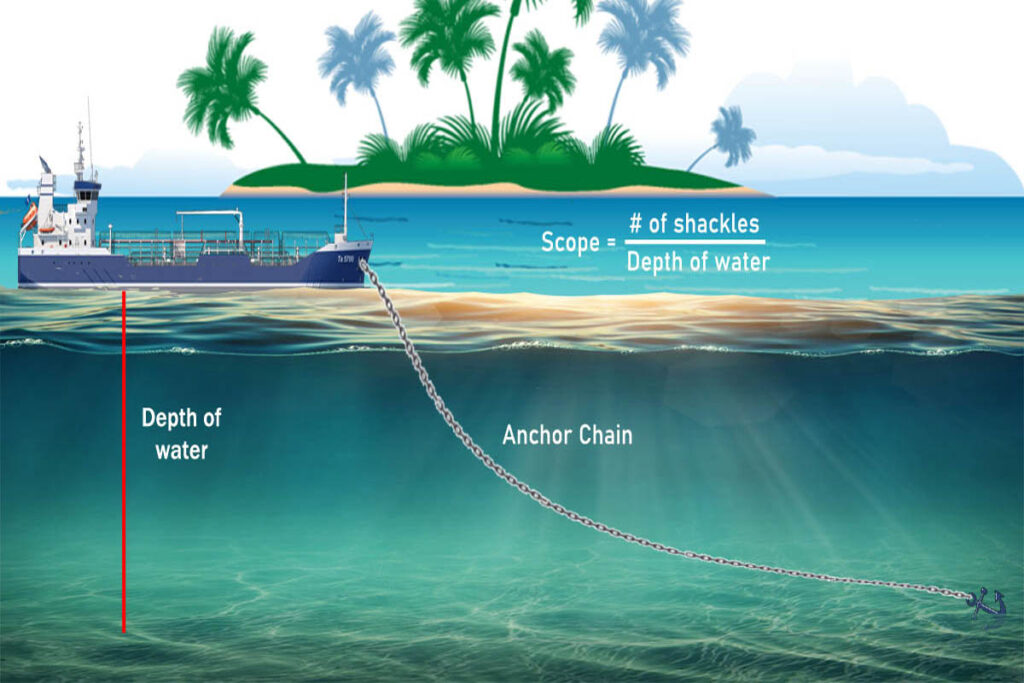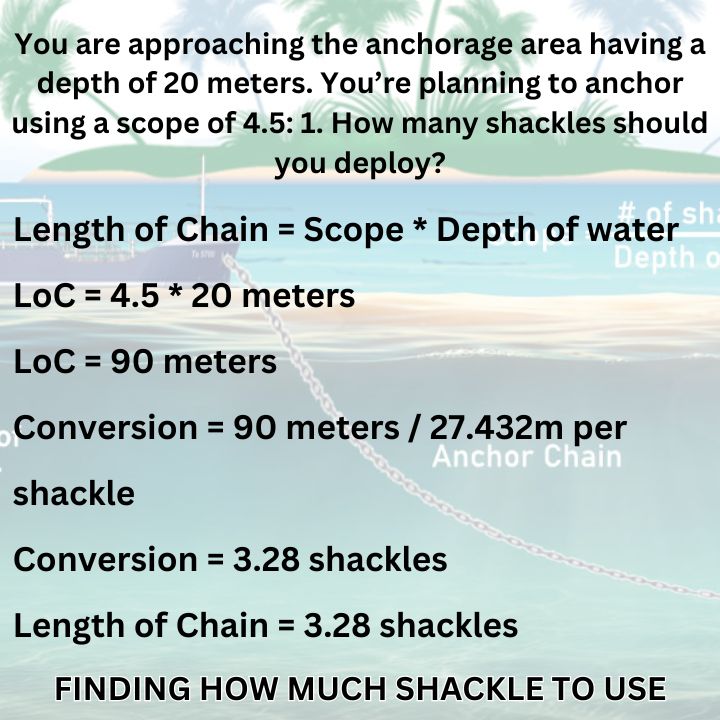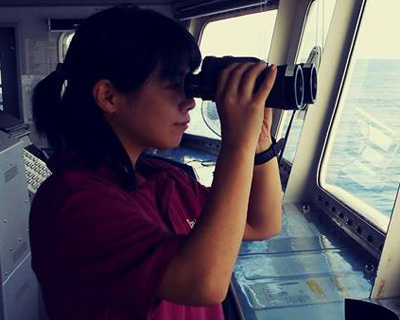All ships, no matter how big or small, have anchors installed to firmly fix the vessel’s position when needed. With this, they must also know the proper scope of the chain to attain maximum holding power.
It was my first anchoring on the bridge when our captain asked me about the right scope for that environment. Without batting an eye, I immediately told him “7:1” or seven times the depth of the water!
I was a deck cadet then, and little did he know that the third officer taught me about that subject. I was sure to earn another signature on my Training Record Book (TRB) until he elaborated on the subject, which I will share here.
What is Anchor Scope?
Anchor scope is the ratio between the length of the anchor chain or cable paid out and the depth of the water in which the vessel is anchored.
It is also called the scope of the anchor and is typically expressed as a numerical ratio such as 3:1, 5:1, or 7.5:1. In some cases, stating the scope is as straightforward as “five times the depth of the water“.
This means you have to pay out the cable five meters (or feet) for every 1 meter (or feet) of water depth. Thus, with a water depth of 20 meters, you must deploy 100 meters of the anchor chain or 3.5 to 4 shackles.
Don’t worry about the math; we will have more later.
Here is a visual representation of the scope.

Anchor scope formulas and calculations
Finding the scope of the anchor is very simple as it uses basic algebra. It involves conversions in fathoms, shackles (also called shots), feet, and meters.
Here is the formula for finding the scope of the anchor.
SCOPE = Length of Chain / Depth of water
That’s it!
Also, note that both given should have the same unit of measure. For reference, here are their equivalent conversions:
- 1 shackle = 15 fathoms
- 1 shackle = 90 feet
- 1 shackle = 27.432 metres
- 1 fathom = 6 feet
Sample problem:
Here’s a sample problem for finding the scope of the anchor.
Your ship is anchored with 7 shackles in the water and a water depth of 30 meters. Find the anchor scope.
Solution:
Scope = Length of Chain / Depth of water
Scope = 7 shackles / 30 meters
Let’s convert shackles to meters.
- Conversion = 7 shackles * 27.432 meters
- Conversion = 192.024 meters
Scope = 192.024 meters / 30 meters
Scope = 6.4
Or we can actually round it off to 6.5 to be on the safe side.

Finding the number of shackles
However, it’s not like we approach the anchorage, drop the anchor, start calculating the scope, and adjust it to the right mix.
Before we even start anchoring, we must already have a plan on how much scope to use based on some factors listed below.
So, to re-purpose the formula, here is a new problem we’ll try to tackle.
You are approaching the anchorage area, having a depth of 20 meters. Due to the available swinging room and the existing local regulations, you can only anchor using a scope of 4.5. How many shackles should you deploy?
Solution:
Length of Chain (LoC) = Scope * Depth of water
LoC = 4.5 * 20 meters
LoC = 90 meters
Let’s convert meters to shackles.
- Conversion = 90 meters / 27.432 meters per shackle
- Conversion = 3.28 shackles
Length of Chain = 3.28 shackles
Again, we can round it off to 3.5 shackles.

If you don’t want to get into the trouble of facing maths and just need to quickly know how many shackles to use for anchoring, you can always refer to our very handy anchor scope and chain length calculator.
Why is choosing the right scope important?
To prevent anchor dragging.
That’s the most crucial reason ship masters calculate the scope before dropping the anchor.
When the proper scope is achieved, the anchor can provide optimal holding power, ensuring the vessel remains safely anchored.
Insufficient scope can compromise the anchor’s effectiveness, leading to dragging, which can be very difficult.
However, deploying too much anchor scope can cause problems of its own.
This is known as over-scoping, and it can reduce the anchor’s holding power and create fouling hazards, entanglement, and difficulty in heaving up.
Factors to consider when computing for the scope.
The ideal scope is between 5:1 and 8:1, depending on many factors. Sometimes, 10:1 can be good, and even 3:1. We just have to figure out some things before dropping the anchor.
As I said, insufficient scope of the anchor can cause dragging, and over-scoping may result in other problems.
Here are factors to consider in determining the scope:
1. Water depth – The depth of the water is the most crucial factor in determining the anchor scope, as this will have the most effect on the angle and catenary of the chain.
2. Type of seabed – The nature of the seabed (mud, sand, rock, etc.) affects how well the anchor can grip. Different seabeds may require cable adjustments for optimal holding.
3. Meteorological conditions – A shorter anchor scope may be sufficient during calm weather, but a longer one may be necessary to prevent the anchor from dragging during windy conditions.
4. Current – The speed and direction of water currents influence the anchor’s performance. Strong currents may require a longer scope to maintain a secure hold.
5. Local regulations – Some anchorage areas have a pre-determined swinging circle for each vessel. Consider that calculation in determining the scope of your chain.

7. Type of anchor – Different designs have varying holding capabilities. The type of anchor being used should be considered.
8. Available swing room – The anchorage area may be packed with other anchoring ships or close to the shore.
9. Size and type of vessel – Larger vessels are heavier and generally require a longer scope to ensure proper holding. The windage area of each ship is also a crucial consideration.
10. Local Knowledge and Experience – This one tends to be the most reliable, especially for captains who know the area well. Firsthand experience can prove invaluable in making informed anchoring decisions.
Final Note
Some ship captains consider the scope to be the length between the anchor chain and the distance from the sea bottom to the hawse pipe of the anchor.
However, the difference will be very slim since even the actual scope is adjusted, and capturing the correct number of shackles to use while anchoring may prove difficult.
May the winds be in your favor.



0 Comments